Released May 9, 2019
Changes to the “Allow Appraiser View” Option
Employee Summary Comments Visible to Appraisers
The Allow Appraiser View option gives appraisers the ability to see, prior to merging, any scores or comments an employee enters on the evaluation screens while performing their self-appraisal. With this release, it will also allow appraisers to see, prior to merging, any information entered by the employee on the Summary Comments screen. This information is “read-only” and visible to appraisers, upline managers with Downline View, and Administrators (company unit or full admins). The feature is still activated on the System Setup > Company Settings > Appraisal Settings tab in the Self-Evaluation section and will apply to default and concurrent appraisals (if concurrent appraisals are activated.)

When an appraiser is on the Summary Comments screen, the employee’s comments (if they have been entered) will appear at the bottom of the page in the employee area.
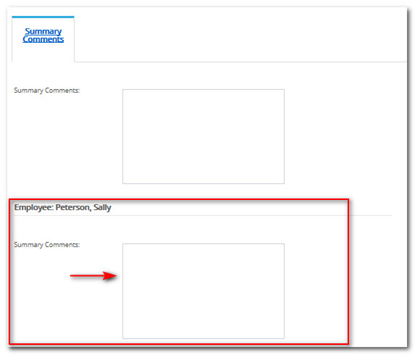
Allow Multi-Appraiser View
A new feature has been added that will allow appraisers to see, prior to merging, any scores or comments that have been entered by assigned multi-appraisers. Previously, only Administrators could see this information prior to the merge. The Allow Multi-Appraiser View option will appear when the Multi-Appraisers feature is activated on the System Setup > Company Settings > Appraisal Settings tab in the Advanced Features area.

When activated, the information will display on a Multi-Appraiser tab located in each of the evaluation criteria sections (Evaluate Core Values, Evaluate Competencies, and Evaluate Goals.) The information is incorporated into two tables. The top table displays the scores given for the criteria section (Core Values, Competencies, or Goals) and the bottom table contains links to any comments. The employee’s input is in the second column, followed by the Primary Appraiser, and then the Multi-Appraisers in the order in which they were set up on the Assign Multi-Appraisers tab.
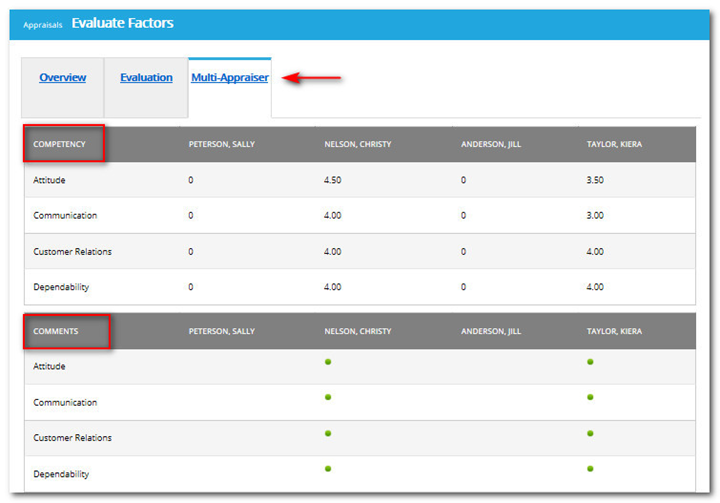
If the Multi-Appraisers were marked Confidential in Multi-Appraiser Setup, their name in the table will be replaced with “Confidential.”
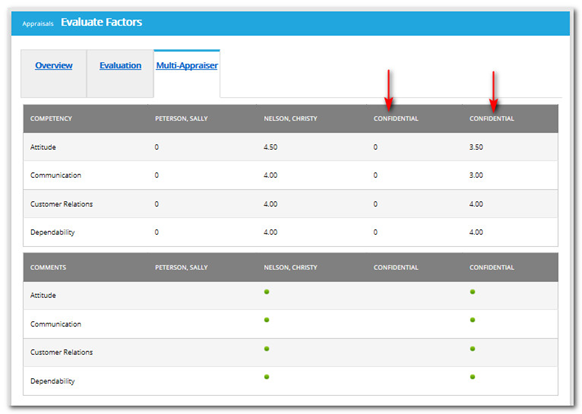
If a comment has been made for a Core Value/Competency/Goal, a green dot will display (Show). If the dot is clicked, a box will open below the comment table showing the corresponding comment. While a comment is showing, the green dot changes to a Hide icon. Clicking this Hide icon will hide the comment.
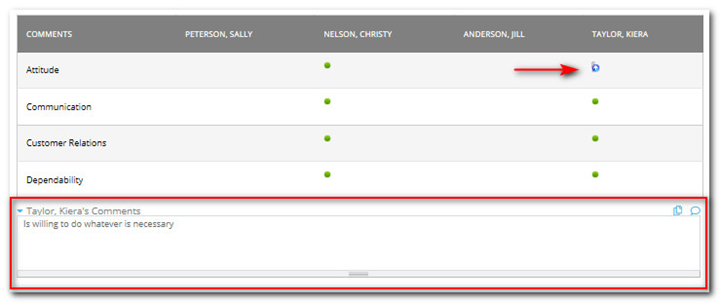
No changes have been made to the Administrative User view of the Multi-Appraiser tab. It will continue to display one Core Value/Competency/Goal per page from which Multi-Appraiser scores can be adjusted if necessary.
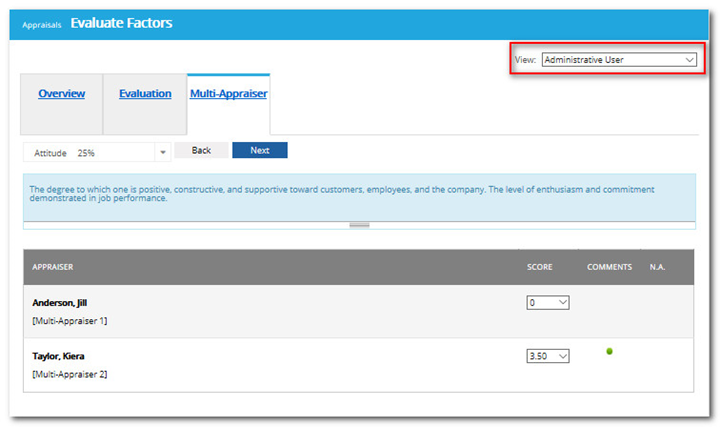
New Self-Appraisal Due Date Field
To better facilitate the appraisal process, Administrative Users can now establish a due date for the employee to complete their self-appraisal. The field is located on the Manage Employees > Employee Data screen in the Appraisal Settings area. It will not apply to concurrent appraisals, only the default appraisal. For appraisers, this field is read-only.

When setting up email alerts, Administrators can now choose to send employee self-appraisal alerts based on the self-appraisal due date or the appraisal end date.
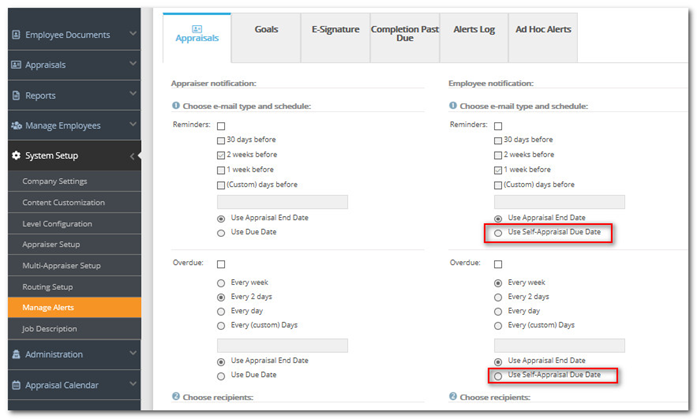
The self-appraisal due date is now a search range option on the Cycle Status report and the Employee Information (Detailed) report.
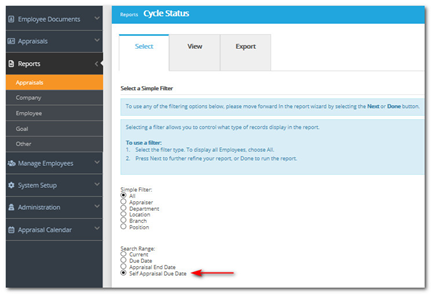
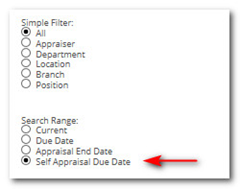
Goal Progress Can Display as a Percentage
A new option will now display when the “Set Progress” feature is enabled in Company Settings. The option titled “Display as a Percentage” will let goal progress be measured on the evaluation and Employee Goal Tools screens in 10% increments instead of Not Started/In Progress/Complete.

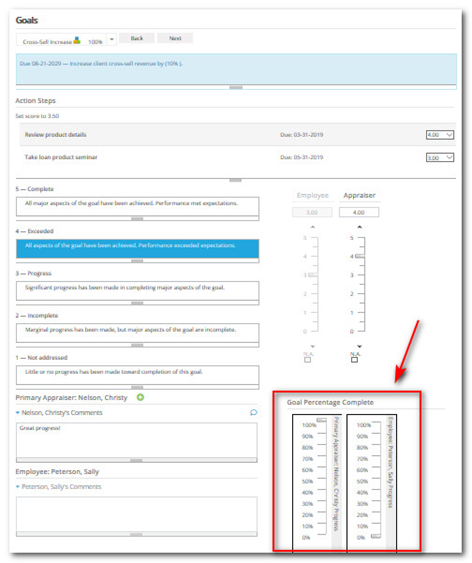
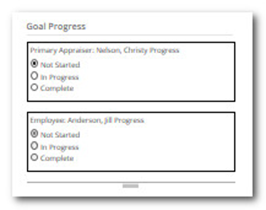

The Detailed Goal Report tracks goal progress and will reflect the current progress in percentages for both employee and appraiser, if applicable for both. Employee Goal Status and Appraiser Goal Status will need to be selected on the Show & Hide Columns page when setting up the report in order for them to appear when the report is run.
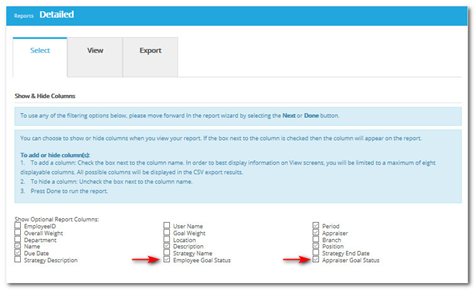
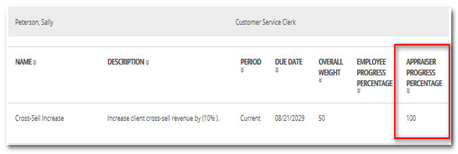
New Auto Completion and Signature Upon Approval
If Routing is activated and the Routing Method is set to Auto Route, a new option is now available titled: “Auto Completion and Signature Upon Approval.”
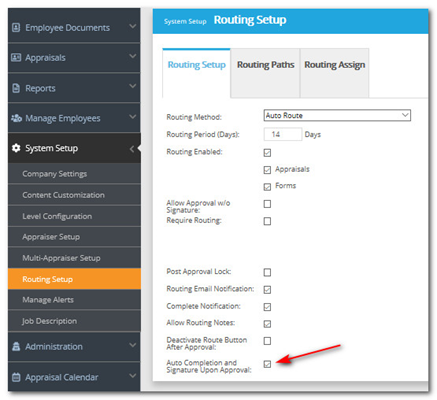
The feature functions as follows: When an appraisal has completed the entire routing path and all routing recipients have marked "Approved" or "Approved w/o Signature," then the appraisal will automatically complete and, if e-signature is turned on for any of the following roles, it will mark the signature complete:
- Appraiser
- Multi-Appraiser
- Upline
- Admin
However, it will NOT sign for the employee. The employee will receive an email notification and the appraisal will appear in the "To Be Signed" widget on their home screen. This will apply to both default and concurrent appraisals, if the Concurrent Appraisal feature is turned on.
If any other status is selected by routing recipients (Approved with Edits, Not Approved, Skipped, or Bypassed), the completion and e-signatures will not auto complete and will need to be performed manually.
If the appraisal is ever un-completed, it will remove the completion status and all e-signatures associated with the appraisal. It will return to the last step in the appraisal process (on the complete tab w/complete button), keeping all routing history, statuses and routing notes intact. The appraisal then must be completed and e-signatures made manually. The appropriate email notifications will go out and the appraisal will appear in the “To Be Signed widget.”
Changes to the Merit Matrix/Increase Feature
A new field titled “Prorated Pay Amount” has been added to the Manage Employees > Employee Data > Salary tab. It will display when the Merit Matrix function is NOT hidden in Company Settings. Data will fill this field based on a calculation of the “Pay Amount” x “Pro-Ration” fields. The field was added so managers involved in the salary budgeting process would have the actual pro-rated salary amount for that year available without having to calculate it manually. A full year salary will display in the Adjust Merit Pay table for full-year budgeting purposes.
In the example below, the employee has a pro-ration figure of .50, meaning the employee would only be eligible for a merit increase on 50% of their annual salary, which is $25,000. If the default of 1 is in the Pro-Ration field, the Prorated Pay Amount field will display the same value as the Pay Amount.
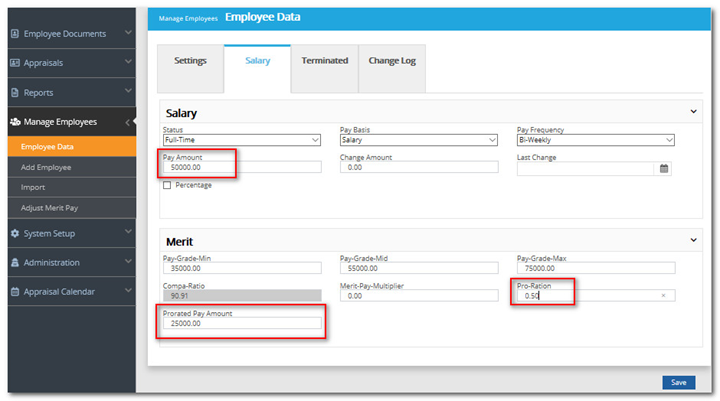
The Prorated Pay Amount field is not importable and will appear in the Employee Information (Detailed) report which is viewable as a .csv document. It will also appear as a column if you export the Adjust Merit Pay table.

Some changes have also been made to the Adjust Merit Pay table.
New Adjust Merit Pay Table

Prior to release

Previously, the Current Pay $ field on the Adjust Merit Pay table displayed the pro-rated salary amount (if a pro-ration was in effect). With this release the Current Pay $ field will now display the full annual salary.
A new “Future” column has been added. The Future Pay $ will display the Current Pay $ plus any Increase $, Lump Sum $, and/or Proposed Adjustment $.
The new Future Lump $ column will calculate the Projected Lump Sum $ plus or minus any Proposed Adjustment amounts. It will function as follows:
If the Current Pay $ is greater than the Pay Grade Max (from Employee Data > Salary tab), then any positive value entered in the Proposed Adjustment field will be added to the Future Lump Sum $ field and NOT the Future Pay $ field.
If the Current Pay $ is less than the Pay Grade Max (from Employee Data > Salary tab), then any positive value entered in the Proposed Adjustment field will be added to the Future Pay $ field, up to the amount that is equal to the Pay Grade Max. Any amount over the Pay Grade Max will be added to the Future Lump Sum $ field.
If the Projected Lump Sum $ has any value, then any negative value entered in the Proposed Adjustment $ cell will be deducted from the Future Lump Sum $ cell unless it was more than the Lump Sum $ then see the following example:
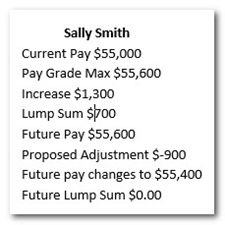
Changes have been made to the superscripts that appeared below the Adjust Merit Pay table. They will now appear above AND below the table and will display as follows:
New superscripts

Prior to release

The previous superscripts, #1 and #2, have been combined and now display as #1. Superscript #3 has been removed because the Current Pay $ column now displays a full salary instead of a pro-rated salary. The previous superscript #4 is now #2. The superscript legend appears at both the top and bottom of the Adjust Merit Pay table.
Did this answer your question?
